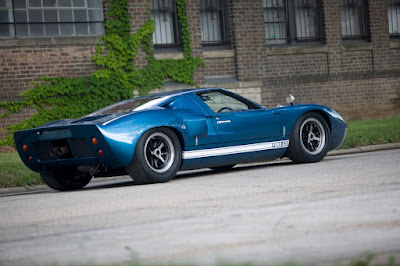Civilized Anglo-American GT was the first Motown-branded Supercar and set a new standard for street performance.
Before Ford’s GT40s made history at Le Mans, Ford announced that Shelby American would handle distribution of a street-legal GT: GT40 Mark I Road Coupe. Based on GT40 Mark I racecars, these Road Coupes would be built at Ford Advanced Vehicles, Slough, UK under the supervision of John Wyer.
“Shelby American will handle the sale of at least 50 of the sleek machines, base priced at $16, 250, at our Los Angeles facility,” said Carroll Shelby. In June 1966 David Heerensperger, Spokane, WA, took delivery of Road Coupe P/1043 with RHD, 48-mm Webers and optional air conditioning from Shelby, above, top. Colin Comer currently owns the car, now fitted with alloy knock-offs in place of the narrow Borrani wires and dressed with GT40 rocker stripes, above. Its engine is currently equipped with 52-mm Webers and Gurney-Westlake heads. The original invoice was approximately $20,000!
According to Ford Motor Company literature, street GTs were to be powered by 385-horsepower solid-lifter high-performance 289 cubic-inch engines, balanced, blueprinted and fitted with Weber carburetion by Shelby American. Similar engines powered Ford GTs that posted podium finishes at the Daytona Continental and 12-hour race at Sebring. Cars were shipped to Shelby in primer powered by SGT/6 numbered engines. P/1043, above, was finished in Shelby’s Guardsman Blue.
Introduced by Ford in Europe, the GT/GT40 project was turned over to Shelby American early in 1965 for further development and racing. The car was designed for competition in FIA’s GT Prototype and was the first American racecar to defeat all European competitors in back-to-back endurance (12 hours or more) races.
Ford’s Mark I is built around a semi-monocoque platform with a mid-mounted V-8 mated to a five-speed ZF transaxle with a limited-slip differential. In the day it was one of the most sophisticated road holding machines, with its suspension designed with the help of computers. Sitting just 40.5 inches off the ground with a 95-inch wheelbase, its aerodynamic design resulted in over 200 mph performance. The street versions were needed to help meet the FIA 50-car homologation specifications so that Ford GT40s could run at Le Mans.
NOTE: When Ford later signed off on the GT40 Mark III street car (with eight-inch longer body and stowage space), Shelby became the official U.S. distributor. It was priced around $18,000.
Colin Comer, is an accomplished historic racer, vintage car collector, and owns and operates Colin’s Classic Automobiles, a collectible car sales, service and restoration facility in Milwaukee, WI. He is also author of The Complete Book of Shelby Automobiles, right, which has a chapter on GT40s and coverage of P/1043. His latest book is, SHELBY COBRA Fifty Years.
For the complete story of GT40 P/1043, please visit, http://www.colinsclassicauto.com/detail.php?car=191
Check out Colin Comer’s bookstore, http://colincomerbooks.com/The-Complete-Book-of-Shelby-Automobiles-CBoS.htm
For more information about Ford’s GT40 Mark III, please visit,
http://www.carguychronicles.com/2011/10/ford-gt40-mk-iii-mayhem-in-manhattan.html




